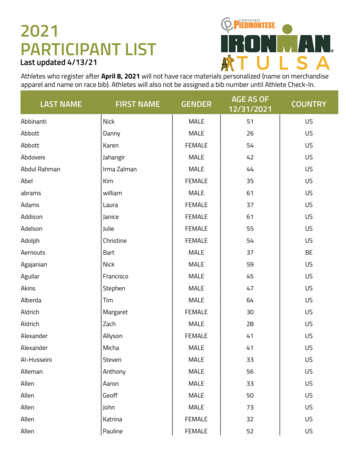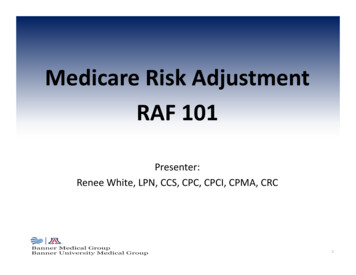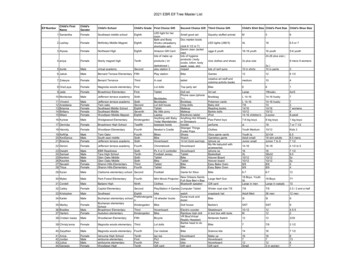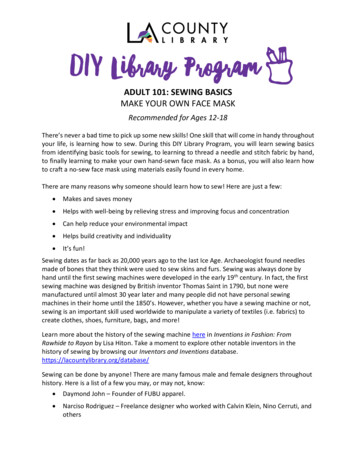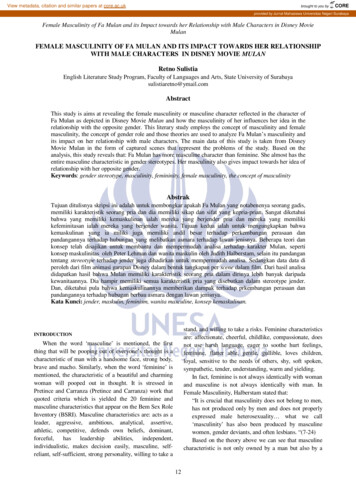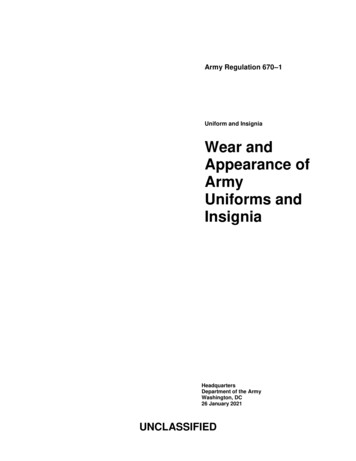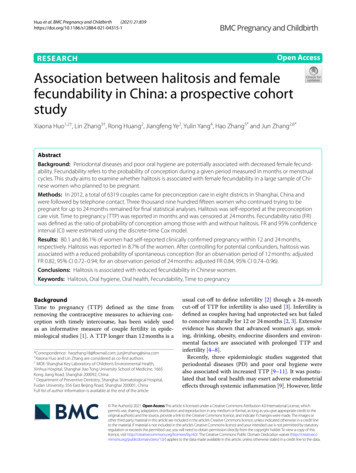
Transcription
(2021) 21:839Huo et al. BMC Pregnancy and -1Open AccessRESEARCHAssociation between halitosis and femalefecundability in China: a prospective cohortstudyXiaona Huo1,2†, Lin Zhang3†, Rong Huang2, Jiangfeng Ye2, Yulin Yang4, Hao Zhang5* and Jun Zhang2,6*AbstractBackground: Periodontal diseases and poor oral hygiene are potentially associated with decreased female fecundability. Fecundability refers to the probability of conception during a given period measured in months or menstrualcycles. This study aims to examine whether halitosis is associated with female fecundability in a large sample of Chinese women who planned to be pregnant.Methods: In 2012, a total of 6319 couples came for preconception care in eight districts in Shanghai, China andwere followed by telephone contact. Three thousand nine hundred fifteen women who continued trying to bepregnant for up to 24 months remained for final statistical analyses. Halitosis was self-reported at the preconceptioncare visit. Time to pregnancy (TTP) was reported in months and was censored at 24 months. Fecundability ratio (FR)was defined as the ratio of probability of conception among those with and without halitosis. FR and 95% confidenceinterval (CI) were estimated using the discrete-time Cox model.Results: 80.1 and 86.1% of women had self-reported clinically confirmed pregnancy within 12 and 24 months,respectively. Halitosis was reported in 8.7% of the women. After controlling for potential confounders, halitosis wasassociated with a reduced probability of spontaneous conception (for an observation period of 12 months: adjustedFR 0.82, 95% CI 0.72–0.94; for an observation period of 24 months: adjusted FR 0.84, 95% CI 0.74–0.96).Conclusions: Halitosis is associated with reduced fecundability in Chinese women.Keywords: Halitosis, Oral hygiene, Oral health, Fecundability, Time to pregnancyBackgroundTime to pregnancy (TTP) defined as the time fromremoving the contraceptive measures to achieving conception with timely intercourse, has been widely usedas an informative measure of couple fertility in epidemiological studies [1]. A TTP longer than 12 months is a*Correspondence: haozhang18@foxmail.com; junjimzhang@sina.com†Xiaona Huo and Lin Zhang are considered as co-first authors.2MOE‑Shanghai Key Laboratory of Children’s Environmental Health,Xinhua Hospital, Shanghai Jiao Tong University School of Medicine, 1665Kong Jiang Road, Shanghai 200092, China5Department of Preventive Dentistry, Shanghai Stomatological Hospital,Fudan University, 356 East Beijing Road, Shanghai 200001, ChinaFull list of author information is available at the end of the articleusual cut-off to define infertility [2] though a 24-monthcut-off of TTP for infertility is also used [3]. Infertility isdefined as couples having had unprotected sex but failedto conceive naturally for 12 or 24 months [2, 3]. Extensiveevidence has shown that advanced woman’s age, smoking, drinking, obesity, endocrine disorders and environmental factors are associated with prolonged TTP andinfertility [4–8].Recently, three epidemiologic studies suggested thatperiodontal diseases (PD) and poor oral hygiene werealso associated with increased TTP [9–11]. It was postulated that bad oral health may exert adverse endometrialeffects through systemic inflammation [9]. However, little The Author(s) 2021. Open Access This article is licensed under a Creative Commons Attribution 4.0 International License, whichpermits use, sharing, adaptation, distribution and reproduction in any medium or format, as long as you give appropriate credit to theoriginal author(s) and the source, provide a link to the Creative Commons licence, and indicate if changes were made. The images orother third party material in this article are included in the article’s Creative Commons licence, unless indicated otherwise in a credit lineto the material. If material is not included in the article’s Creative Commons licence and your intended use is not permitted by statutoryregulation or exceeds the permitted use, you will need to obtain permission directly from the copyright holder. To view a copy of thislicence, visit http:// creat iveco mmons. org/ licen ses/ by/4. 0/. The Creative Commons Public Domain Dedication waiver (http:// creat iveco mmons. org/ publi cdoma in/ zero/1. 0/) applies to the data made available in this article, unless otherwise stated in a credit line to the data.
Huo et al. BMC Pregnancy and Childbirth(2021) 21:839is known about the association between oral health problems and TTP in Asian populations.Halitosis, commonly called “bad breath” or “oral malodor”, is defined as an unpleasant or offensive odor mostlyarising from the oral cavity [12, 13]. It is prevalent worldwide and affects all ages [14, 15]. More than 80% of thecases had intra-oral causes a, such as poor oral hygiene,gingivitis, periodontitis and dry mouth [13, 16–18].Keeping clean and healthy oral conditions, as well asperiodontal treatment have been shown to be the mostbasic and effective methods to prevent and reduce halitosis [19]. Therefore, we hypothesize that halitosis might bea proxy for overall poor oral health. This study aimed toinvestigate the association between halitosis and femalefecundability in a prospective study in Chinese women.MethodsStudy design and study populationIn recent years, the Chinese government has been promoting preconception care for couples who plan to bepregnant. In the Shanghai municipality, China, each district has a designated preconception care clinic usuallylocated in a maternity care facility. Registered residentsin the corresponding district may obtain a voucher fromtheir community to receive free care in the designatedclinic. At the visit, couples are first informed by healthcare workers on the purpose and procedures involved inthe preconception care and are asked to sign a consentform. Information on demographic characteristics, medical history, family history, health behavior and lifestyleare collected. Physicians conduct a physical examinationon the couples. Routine blood and urine tests are performed. Couples are provided with health education onhow to prepare a healthy pregnancy such as folate supplementation and smoking cessation. After the blood andurine test results are obtained, physicians provide a riskassessment and counseling to the couple. Women arecontacted by health care workers via telephone calls at 3,6, 12 and 24 months after the care encounter. If a womanbecomes pregnant, information on pregnancy and pregnancy outcomes is collected. Women were asked “Haveyou had a clinically diagnosed pregnancy? For how manymonths have you tried to conceive?”Eight out of 17 Shanghai districts were randomlyselected in an evaluation study by the municipal government. The purpose of the study was to evaluate thebenefits and effectiveness of the free preconception careprogram. The current analysis utilized the data from theevaluation study.From January 2012 to December 2012, a total of 6319couples sought preconception care at these clinics.Exclusion criteria were couples who 1) had infertility history; 2) were lost to follow-up; 3) changed the pregnancyPage 2 of 8plan; 4) were diagnosed with male infertility; 5) acceptedassisted reproductive technology; 6) had missing dataon oral malodor; 7) had missing data on TTP. Figure 1illustrates the sample selection process. In the end, 3915couples remained for final analyses. Among them, 3369(86.1%) women had given birth or were pregnant at thetime of the final follow-up at 24 months while 546 (13.9%)women had not been pregnant during the entire followup period. This study was approved by the Ethics Committee of Xinhua Hospital Affiliated to Shanghai JiaoTong University School of Medicine, Shanghai, China.MeasuresHalitosis was a self-reported item in the questionnairewith responses of yes/no. Halitosis refers to unpleasant odor currently originating from mouth that wasdetected by herself or others, or diagnosed clinically,and regardless of whether it was acute or chronic. Theoutcome was natural conception within the status ofpregnancy at 12 and 24 months. TTP was defined as thenumber of months that a couple were trying to conceivespontaneously.Statistical analysisBivariate analyses were conducted to assess the association between socio-demographic characteristics andhalitosis by Chi-square tests and Mann-Whitney U tests.Therefore, fecundability ratio (FR) and 95% confidenceinterval (CI) for halitosis were calculated in the Cox proportional hazard model for discrete-time survival analysis. A FR 1 represents reduction in fecundability, and aFR 1 represents higher fecundability. The TTP was censored at 12 or 24 months in the corresponding analyses,respectively.A set of potential confounders were selected based ona directed acyclic graph (DAG, Supplementary Fig. 1) inconsideration of previous reports [12], including femaleage at preconception care ( 25, 25–30, 30–35, 35–40, 40 years), BMI at preconception care ( 18.5, 18.5–24.9,25–29.9, 30 kg/m2), indicators of socioeconomic status(female occupation [teachers, civil servants and businessmen; farmers, workers and waiter; housewife or others]and education level [ 9, 10–12, 13–16, 17 years]),smoking status (yes, no, unknown), alcohol consumption(yes, no, unknown), diet (dislike to eat vegetables and liketo eat raw meat), indicators of psychological stress (perceived life or work-related stress; tension with relatives,friends or colleagues; and financial pressure), medicalhistory (including anemia, hypertension, heart disease,diabetes, thyroid disease, chronic nephritis, tumor, tuberculosis and hepatitis B; yes, no) and gingival bleeding(yes, no, unknown). Fully conditional specification (FCS)methods of multiple imputation was applied to deal with
Huo et al. BMC Pregnancy and Childbirth(2021) 21:839Page 3 of 8Fig. 1 Study Flow Chartthe missing data for confounders [20, 21]. To rule out thepotential modification effect of chronic inflammationdue to periodontal disease on the association of interest,we conducted subgroup analyses by stratifying whethera woman had frequent gingival bleeding. Kaplan-Meiersurvival curves and log-rank test were used to assess thebivariate association between halitosis and fecundabilitywithin 24 months. All statistical analyses were conductedusing SAS version 9.4 (SAS Institute Inc., Cary, NC,USA).ResultsAmong the 3915 women, 3136 (80.1%) and 3369 (86.1%)became pregnant within 12 and 24 months, respectively. The prevalence of self-reported halitosis was 8.7%.The mean age of these women was 28.0 (range 20–49)years. The vast majority was Han ethnicity (98.7%) andhad normal weight (73.1%). Those with self-reportedhalitosis had a lower level of education, and were morelikely to smoke, drink, dislike to eat vegetable, and liketo eat raw meat. They were also more likely to perceivea higher level of life or work-related stress and financial pressure, have a tense relationship with relatives,friends or colleagues, and a higher prevalence of gingivalbleeding (Table 1). They had a slightly longer TTP. 73.1%of women in the halitosis group reported a clinically confirmed pregnancy by 12 months, while 80.8% did so in thenon-halitosis group.Table 2 shows that compared with women withouthalitosis, those with halitosis had reduced fecundabilityin the observation period of 12 months (adjusted FR 0.82,95% CI 0.72–0.94) and 24 months (adjusted FR 0.84, 95%CI 0.74–0.96) after controlling for potential confounders. Figure 2 shows that women without halitosis werequicker to become pregnant. Stratified analyses by gingival bleeding further showed that halitosis was associatedwith decreased fecundability regardless of gingival bleeding (Table 3).DiscussionOur study shows that among Chinese women in Shanghai who planned to be pregnant, 80.1 and 86.1% becamepregnant within 12 and 24 months, respectively. Wealso found that halitosis was negatively associated withfemale fecundability. Our study was consistent with theother three studies that reported an association of poororal health and periodontal diseases and prolonged TTP.A case-control study involving 58 non-pregnant women
Huo et al. BMC Pregnancy and Childbirth(2021) 21:839Table 1 Baseline characteristics of women by halitosis status, N 3915Page 4 of 8Halitosis N 342Non –halitosisN 3573Han337 (98.5)3535 (98.9)Others5 (1.5)38 (1.1)EthnicityAge at preconception care (years) 2545 (13.2)409 (11.5)25–29181 (52.9)2083 (58.3)30–34106 (31.0)952 (26.6)35–3910 (3.0)111 (3.1) 400 (0.0)18 (0.5) 9Educational level (years)13 (3.8)114 (3.2)10–1241 (12.0)367 (10.3)13–16268 (78.4)2730 (76.4)20 (5.9)362 (10.1)Teachers, civil servants and businessmen161 (47.1)1791 (50.1)Farmers, workers and waiter43 (12.6)486 (13.6)Housework or others138 (40.4)1296 (36.3) 17OccupationBMI at preconception care (kg/m2)a 18.573 (21.4)676 (18.9)18.5–24.9240 (70.2)2622 (73.4)25–29.923 (6.7)220 (6.2)1 (0.3)38 (1.1)5 (1.5)17 (0.5) 30UnknownSmoking statusNever329 (96.2)3542 (99.1)Yes13 (3.8)30 (0.8)Unknown0 (0.0)1 (0.03)Never246 (71.9)2859 (80.0)Occasionally91 (26.6)689 (19.3)Frequently5 (1.5)19 (0.5)Unknown0 (0.0)6 (0.2)No319 (93.3)3462 (96.9)Yes23 (6.7)111 (3.1)No316 (92.4)3453 (96.6)Yes26 (7.6)120 (3.4)No58 (17.0)917 (25.7)Yes284 (83.0)2656 (74.3)No222 (64.9)2830 (79.2)Yes120 (35.1)743 (20.8)No136 (39.8)1848 (51.7)Yes206 (60.2)1725 (48.3)Alcohol consumptionDislike to eat vegetablesLike to eat raw meatPerceived life or work-related stressTension with relatives, friends or colleaguesFeeling of financial pressure
Huo et al. BMC Pregnancy and Childbirth(2021) 21:839Page 5 of 8Table 1 (continued)Halitosis N 342Non –halitosisN 3573No272 (79.5)3093 (86.6)Yes70 (20.5)480 (13.4)Medical historybGingival bleedingNo105 (40.7)2239 (62.7)Yes178 (52.0)892 (25.0)Unknown59 (17.3)442 (12.4)6 (3, 12)6 (2, 12)6 (3, 18)6 (3, 12)Time-to-pregnancy [observation period 12 months; Median (p25, p75)]Time-to-pregnancy [observation period 24 months; Median (p25, p75)]aBMI: body mass index; raw meat: meat is not cooked such as sashimibMedical history: anemia, hypertension, heart disease, diabetes, thyroid disease, chronic nephritis, tumour, tuberculosis, hepatitis BTable 2 Multivariate survival analysis of the association between halitosis and time to pregnancyExposureCategoriesObservation period 12 monthsPregnancy n (%)FR95% CIaaFRObservation period 24 months95% CIPregnancy n (%)FR95% CIaaFR95% CIHalitosisNo2886 (80.8)Ref\Ref\3089 (86.5)Ref\Ref\Yes250 (73.1)0.840.74–0.950.820.72–0.94280 (81.9)0.860.76–0.970.840.74–0.96Abbreviation: aFR adjusted fecundability ratioaadjusting for female age at preconception care (years), BMI at preconception care (kg/m2), female occupation (teachers, civil servants and businessmen (reference);farmers, workers and waiter; housewife or others), education level (years), smoking status (no, yes), alcohol consumption (no, occasional, frequent, unknown), disliketo eat vegetables (no, yes), like to eat raw meat (no, yes), perceived life or work -related stress (no, yes), tension with relatives, friends or colleagues (no, yes), financialpressure (no, yes), medical history (no, yes), gingival bleeding (no, yes)and 70 pregnant women reported that women with goodoral hygiene were more likely to be pregnant within 1 yearin African American women [10]. A very recent largeprospective cohort study in North America indicated asignificant association between a self-reported historyof periodontitis and decreased fecundability [11]. Hartet al. reported similar results that periodontal diseasewas associated with prolonged TTP in non-Caucasian(67.1% were Asian and the others were African, Aboriginal, and other ethnicities) women in Australia. But therewas no significant association in Caucasian women [9].The researchers attributed the observed ethnic disparityto the single nucleotide polymorphisms related to periodontal disease [9]. The ethnic disparity in the ability tomount inflammatory/immune responses [9] might beanother possible reason. Furthermore, ethnicity mightbe a proxy for diet, cultural practices, barriers to healthcare access or other structural factors that may affect oralhealth and fertility.Microorganisms, especially anaerobic bacteria, are themain cause of bad breath and PD [16–18, 22]. Previousstudies showed that oral flora can go through uterinecavity, amnion cavity, placenta, and even fetus, and hasbeen suggested to be an important risk factor for recurrent miscarriage, intrauterine death, preterm birth andneonatal death [23–26]. For example, Porphyromonasgingivalis, which plays an important role in the development of halitosis, was found in both periodontal pocketand amniotic fluid of women at high-risk of prematurelabor [25]. A recent study found that Porphyromonasgingivalis infection in female genital tract was associated with recurrent miscarriages [24]. Elevated levels ofinflammatory mediators in saliva and some mediators inserum have been found among pre-conception womenwith periodontal disease [27].Oral bacteria are also found to be associated withinfection at extra-oral locations, such as lung, vasculature and pancreas [28–30]. Bacterial pathogens couldactivate a cascade of tissue-destructive pathways [31,32] and elevated systemic levels of cytokines such astumor necrosis factor alpha, which could lead to chronicsystemic inflammation [33]. Such low-grade systemic
Huo et al. BMC Pregnancy and Childbirth(2021) 21:839Page 6 of 8Fig. 2 Kaplan-Meier curve for time to pregnancy according to halitosis (yes was recorded as 1, and otherwise 0). Quicker to get pregnant isindicated for women without halitosis (Log-Rank P 0.02)Table 3 Multivariate survival analysis of the association between halitosis and time to pregnancy stratified by gingival bleeding statusObservation period 12 monthsObservation period 24 monthsFR95% Exposure CategoriesaFR95% CIFR95% CIa95% CIaFRNon- Gingival bleedingGingival bleedingAbbreviation: aFR adjusted fecundability ratioaadjusting for female age at preconception care (years), BMI at preconception care (kg/m2), female occupation (teachers, civil servants and businessmen (reference);farmers, workers and waiter; housewife or others), education level (years), smoking status (no, yes), alcohol consumption (no, occasional, frequent, unknown), disliketo eat vegetables (no, yes), like to eat raw meat (no, yes), perceived life or work -related stress (no, yes), tension with relatives, friends or colleagues (no, yes), financialpressure (no, yes), medical history (no, yes)inflammation is thought to present an endometrial effectsimilar to endometriosis [10, 34], which could negativelyaffect fertility and conception. Thus, it is reasonableto hypothesize that increased oral pathogenic bacteriamight circulate through bloodstream, enter reproductiveorgan, and then, result in reduced fecundability [24, 25,35] .The present study found a lower prevalence of halitosis (8.7%) in reproductive age women than those in general adult populations in Beijing (27.8%) and Shanghai(33%) [15, 36]. This difference in prevalence may be dueto several factors. First, the previous studies measuredorganoleptic measurements or volatile sulphide compounds, respectively [15, 36], which were likely to bemore sensitive than self-report in our study. Thus, somewomen may have been misclassified in our study. Second, the study populations differed. Our subjects werereproductive-age women, but the subjects in the otherstudies covered a diverse population [15, 35]. It has beenreported that halitosis was more common in those whowere older and perceived more stress, but less commonin younger females [37, 38]. Iwakura et al. [39] suggested
Huo et al. BMC Pregnancy and Childbirth(2021) 21:839that a person who has halitosis may be accompanied bydecreased olfactory function. Thus, underreporting ofhalitosis in these women is possible. Women may alsofeel ashamed to report halitosis. However, this was a prospective study. If halitosis is truly associated with infertility, underreporting of halitosis may have drawn ourresults towards the null to an unknown degree.Our study was also limited by its inability to explorethe underlying causes of halitosis; neither can we provea cause-and-effect relationship. The self-reported halitosis might be an indicator of bad oral health, or symptomsof other medical conditions and illness, including diabetes, or unhealthy behaviors such as smoking and drinking [4, 15]. However, the significant association remainedafter we had adjusted for these factors in the multivariable model. We did not have the information on quantityof alcohol consumption, which was a limitation of ourstudy. Thus, the results of our study should be interpretedwith caution. Future studies are warranted to explore theunderlying mechanisms between the association betweenhalitosis and fecundability.In addition, 28.5% of subjects were lost to follow-up.We compared women who were lost and who remainedin this study. There was no significant difference betweenthese two groups in the prevalence of halitosis (9.2 vs. 8.7,respectively). Thus, the loss-to-follow-up was unlikely tobe differential.ConclusionsOur large prospective cohort study showed that selfreported halitosis was associated with reduced fecundability in Chinese women who plan to become pregnant.More research is warranted to identify modifiable factorsand implement effective prevention strategies to reducethe risk of infertility.AbbreviationsCI: Confidence interval; FR: Fecundability ratio; PD: Periodontal diseases; TTP:Time to pregnancy.Supplementary InformationThe online version contains supplementary material available at https:// doi. org/ 10. 1186/ s12884- 021- 04315-1.Additional file 1: Supplementary Figure 1. Directed acyclic graph illustrated confounders. BMI, body mass index; SES, socioeconomic status.AcknowledgmentsWe thank Dr. Stella Yu for her helpful comments on this manuscript.Authors’ contributionsX Huo designed the study, analyzed the data and drafted the manuscript. LZhang and R Huang helped to revise the manuscript. J Ye and Y Yang participated in the evaluation study and provided critical feedback on manuscriptPage 7 of 8drafts. J Zhang and H Zhang were the Principle Investigators of the project,helped draft the manuscript, critically revised and approved the final version.All authors have reviewed the final version of the manuscript and agreed thesubmission for publication.FundingThis study was supported by the Shanghai Municipal Health Commission(GWV-10.1-XK07).Availability of data and materialsAll data generated or analyzed during this study are included in this publishedarticle.DeclarationsEthics approval and consent to participateThis study was approved by the Ethics Committee of Xinhua Hospital Affiliated to Shanghai Jiao Tong University School of Medicine, Shanghai, China.All participants signed an informed consent. All methods were carried out inaccordance with relevant guidelines and regulations.Consent for publicationNot applicable.Competing interestsThe authors declare that they have no competing interests.Author details1Obstetrics and Gynecology Department, International Peace Maternityand Child Health Hospital of China, Shanghai Jiao Tong University Schoolof Medicine, Shanghai 200030, China. 2 MOE‑Shanghai Key Laboratory of Children’s Environmental Health, Xinhua Hospital, Shanghai Jiao Tong UniversitySchool of Medicine, 1665 Kong Jiang Road, Shanghai 200092, China. 3 Obstetrics Department, International Peace Maternity and Child Health Hospitalof China, Shanghai Jiao Tong University School of Medicine, Shanghai 200030,China. 4 Department of Maternal and Child Health Care, Shanghai MunicipalHealth and Family Planning Commission, 300 Expo Village Road, Shanghai 200125, China. 5 Department of Preventive Dentistry, Shanghai Stomatological Hospital, Fudan University, 356 East Beijing Road, Shanghai 200001,China. 6 Hainan Women and Children’s Medical Center, Haiko, Hainan, China.Received: 9 July 2021 Accepted: 1 December 2021References1. Snijder CA, te Velde E, Roeleveld N, Burdorf A. Occupational exposureto chemical substances and time to pregnancy: a systematic review.Hum Reprod Update. 2012;18(3):284–300.2. Zegers-Hochschild F, Adamson GD, de Mouzon J, Ishihara O, MansourR, Nygren K, et al. International Committee for Monitoring AssistedReproductive Technology (ICMART) and the World Health Organization (WHO) revised glossary of ART terminology, 2009. Fertil Steril.2009;92(5):1520–4.3. Gurunath S, Pandian Z, Anderson RA, Bhattacharya S. Defining infertility-a systematic review of prevalence studies. Hum Reprod Update.2011;17(5):575–88.4. Mokeem SA. Halitosis: a review of the etiologic factors and associationwith systemic conditions and its management. J Contemp Dent Pract.2014;15(6):806–11.5. Tubaishat RS, Malkawi ZA, Albashaireh ZS. The influence of differentfactors on the oral health status of smoking and nonsmoking adults. JContemp Dent Pract. 2013;14(4):731–7.6. Wildenschild C, Riis AH, Ehrenstein V, Hatch EE, Wise LA, Rothman KJ, et al.A prospective cohort study of a woman’s own gestational age and herfecundability. Hum Reprod. 2015;30(4):947–56.7. Balen AH, Morley LC, Misso M, Franks S, Legro RS, Wijeyaratne CN, et al.The management of anovulatory infertility in women with polycystic
Huo et al. BMC Pregnancy and 22.23.24.25.26.27.28.29.30.31.(2021) 21:839ovary syndrome: an analysis of the evidence to support the developmentof global WHO guidance. Hum Reprod Update. 2016;22(6):687–708.Bach CC, Vested A, Jorgensen KT, Bonde JP, Henriksen TB, Toft G.Perfluoroalkyl and polyfluoroalkyl substances and measures of humanfertility: a systematic review. Crit Rev Toxicol. 2016;46(9):735–55.Hart R, Doherty DA, Pennell CE, Newnham IA, Newnham JP. Periodontaldisease: a potential modifiable risk factor limiting conception. HumReprod. 2012;27(5):1332–42.Nwhator S, Opeodu O, Ayanbadejo P, Umeizudike K, Olamijulo J, Alade G,et al. Could periodontitis affect time to conception? Ann Med Health SciRes. 2014;4(5):817–22.Bond JC, Wise LA, Willis SK, Yland JJ, Hatch EE, Rothman KJ, et al. Selfreported periodontitis and fecundability in a population of pregnancyplanners. Hum Reprod. 2021;36(8):2298–308.Seemann R, Conceicao MD, Filippi A, Greenman J, Lenton P, Nachnani S,et al. Halitosis management by the general dental practitioner--results ofan international consensus workshop. J Breath Res. 2014;8(1):017101.Delanghe G, Ghyselen J, van Steenberghe D, Feenstra L. Multidisciplinarybreath-odour clinic. Lancet. 1997;350(9072):187.Akaji EA, Folaranmi N, Ashiwaju O. Halitosis: a review of the literature on its prevalence, impact and control. Oral Health Prev Dent.2014;12(4):297–304.Liu XN, Shinada K, Chen XC, Zhang BX, Yaegaki K, Kawaguchi Y. Oralmalodor-related parameters in the Chinese general population. J ClinPeriodontol. 2006;33(1):31–6.Tonzetich J. Production and origin of oral malodor: a review of mechanisms and methods of analysis. J Periodontol. 1977;48(1):13–20.Kapoor U, Sharma G, Juneja M, Nagpal A. Halitosis: current concepts onetiology, diagnosis and management. Eur J Dent. 2016;10(2):292–300.HajiFattahi F, Hesari M, Zojaji H, Sarlati F. Relationship of halitosis withgastric helicobacter pylori infection. J Dent (Tehran). 2015;12(3):200–5.Suzuki N, Yoneda M, Takeshita T, Hirofuji T, Hanioka T. Induction andinhibition of oral malodor. Mol Oral Microbiol. 2019;34(3):85–96.Lee KJ, Carlin JB. Multiple imputation for missing data: fully conditionalspecification versus multivariate normal imputation. Am J Epidemiol.2010;171(5):624–32.Liu Y, De A. Multiple imputation by fully conditional specification for dealing with missing data in a large epidemiologic study. Int J Stat Med Res.2015;4(3):287–95.Morita M, Wang HL. Relationship between sulcular sulfide level andoral malodor in subjects with periodontal disease. J Periodontol.2001;72(1):79–84.Bieniek KW, Riedel HH. Bacterial foci in the teeth, oral cavity, and jaw-secondary effects (remote action) of bacterial colonies with respect tobacteriospermia and subfertility in males. Andrologia. 1993;25(3):159–62.Ibrahim MI, Abdelhafeez MA, Ellaithy MI, Salama AH, Amin AS, EldakroryH, et al. Can Porphyromonas gingivalis be a novel aetiology for recurrentmiscarriage? Eur J Contracept Reprod Health Care. 2015;20(2):119–27.Leon R, Silva N, Ovalle A, Chaparro A, Ahumada A, Gajardo M, et al.Detection of Porphyromonas gingivalis in the amniotic fluid in pregnantwomen with a diagnosis of threatened premature labor. J Periodontol.2007;78(7):1249–55.Bearfield C, Davenport ES, Sivapathasundaram V, Allaker RP. Possible association between amniotic fluid micro-organism infection and microflorain the mouth. BJOG. 2002;109(5):527–33.Jiang H, Zhang Y, Xiong X, Harville EW. O K, Qian X: salivary and seruminflammatory mediators among pre-conception women with periodontal disease. BMC Oral Health. 2016;16(1):131.Scannapieco FA. Pneumonia in nonambulatory patients. The role of oralbacteria and oral hygiene. J Am Dent Assoc. 2006;137(Suppl):21S–5S.Michaud DS, Izard J, Wilhelm-Benartzi CS, You DH, Grote VA, Tjonneland A,et al. Plasma antibodies to oral bacteria and risk of pancreatic cancer in alarge European prospective cohort study. Gut. 2013;62(12):1764–70.Boillot A, Demmer RT, Mallat Z, Sacco RL, Jacobs DR, Benessiano J,et al. Periodontal microbiota and phospholipases: the Oral infectionsand vascular disease epidemiology study (INVEST). Atherosclerosis.2015;242(2):418–23.Williams RC, Barnett AH, Claffey N, Davis M, Gadsby R, Kellett M, et al. Thepotential impact of periodontal disease on general health: a consensusview. Curr
fecundability in a prospective study in Chinese women. Methods Study design and study population In recent years, the Chinese government has been pro-moting preconception care for couples who plan to be pregnant. In the Shanghai municipality, China, each dis-trict has a designated preconce

